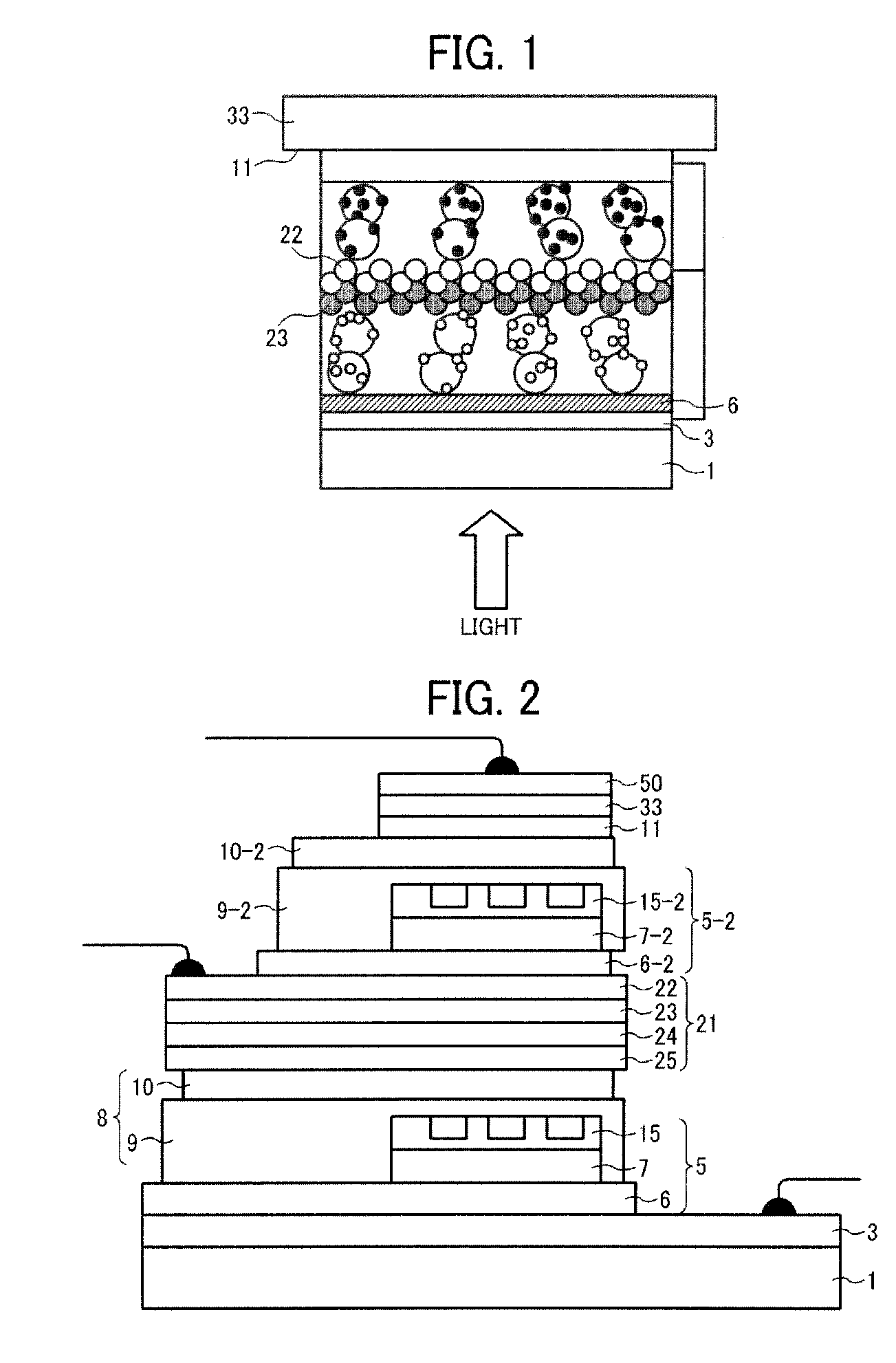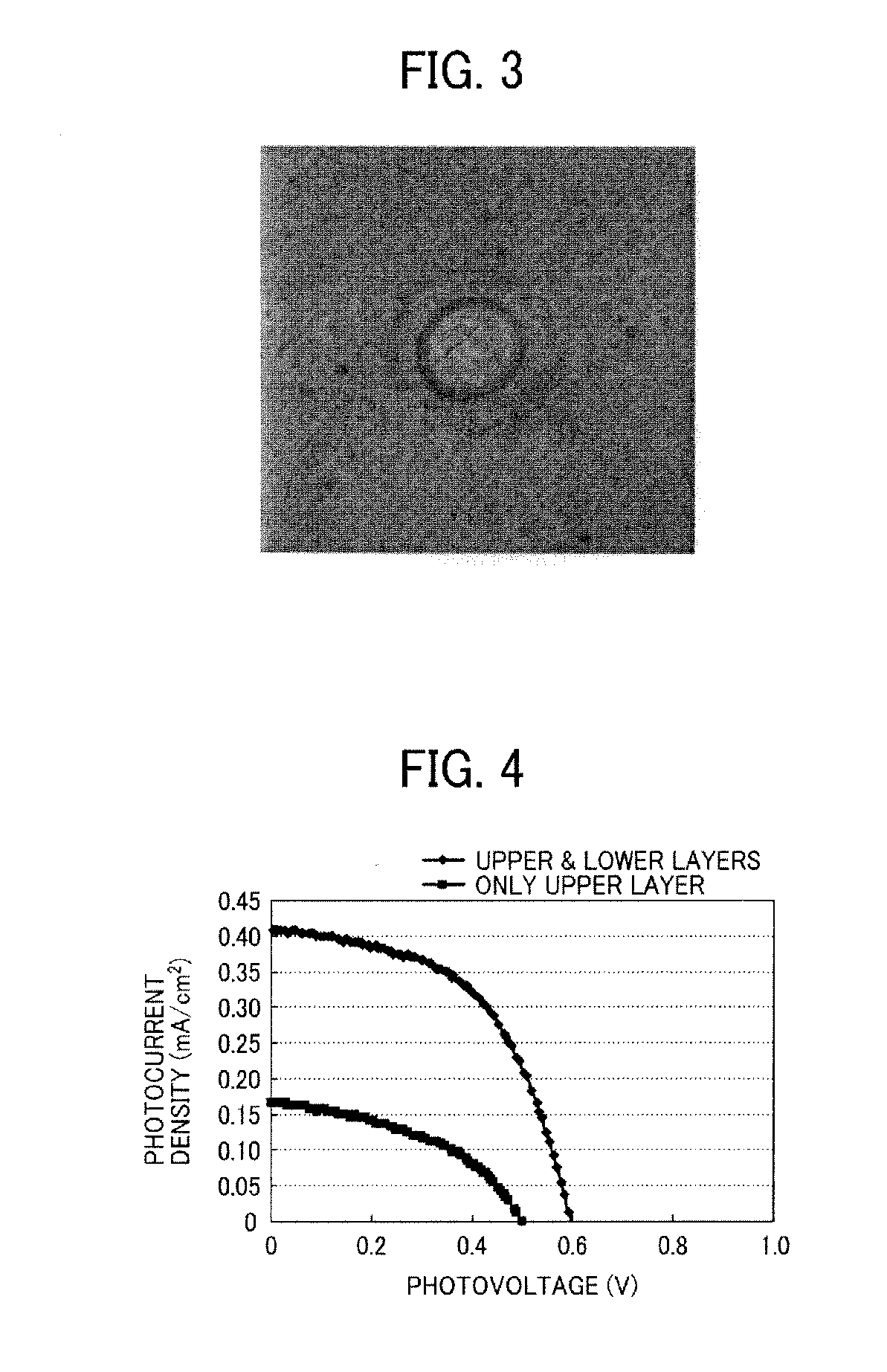Photoelectric converter
a photoelectric converter and converter technology, applied in the direction of capacitors, solid-state devices, electrolytic capacitors, etc., can solve the problems of low efficiency of photoelectric converters, low manufacturing cost of cells, and low efficiency of solar cells
- Summary
- Abstract
- Description
- Claims
- Application Information
AI Technical Summary
Benefits of technology
Problems solved by technology
Method used
Image
Examples
example 1
[0236]A DSSC was prepared as follows.
[0237]Initially, a glass plate with a thickness of 1 mm, a surface of which was coated with a material SnO2:F serving as the first electrode, was provided. When the resistance between two terminals of the first electrode was measured to determine the sheet resistance thereof, the sheet resistance was about 20Ω.
[0238]Next, a nano-sized titanium oxide dispersion (SP210 from Showa Titanium Co., Ltd.) was applied on the first electrode by spin coating, followed by annealing for 15 minutes at 120° C. Thus, a titanium oxide particle layer serving as an electron transport layer was prepared.
[0239]Further, an ethanol solution of a dye D131 having the below-mentioned formula (3) was applied on the titanium oxide particle layer by spin coating, followed by annealing for 10 minutes at 120° C. Thus, a first photoelectric conversion layer including the titanium oxide particle layer and the dye D131 was prepared.
[0240]Next, a layer of ZnS—SiO2 (8 / 2 by mol) hav...
example 2
[0251]A glass plate with a thickness of 1 mm coated with SnO2:F (first electrode) was provided.
[0252]Next, a nano-sized titanium oxide dispersion (T20 from SOLARONIX SA) was applied on the first electrode by a printing method, followed by annealing for 30 minutes at 550° C. Thus, a titanium oxide particle layer with a thickness of 9 μm was prepared.
[0253]In addition, a solution SNOW LATEX MIBK-SZC from Nissan Chemical industries Ltd., which includes silica as a solid component, methyl isobutyl ketone, and methanol at a weight ratio of 45%, 50% and 5%, was applied on the above-prepared titanium oxide particle layer by spin coating at a revolution of 2500 rpm.
[0254]Further, the following components were mixed to prepare a coating liquid.
SNOW LATEX MEK-20401part(silica, from Nissan Chemical industries Ltd.)Aqueous urethane resin5parts(HW-140SF from Dainippon Ink and Chemicals Inc.)2,2,3,3-tetrafluoropropanol95parts(from Daikin Industries, Ltd.)
[0255]The coating liquid was applied on th...
example 3
[0264]A glass plate with a thickness of 1 mm coated with SnO2:F (first electrode) was provided.
[0265]A nano-sized titanium oxide dispersion was coated on the first electrode by spin coating to prepare a dense titanium oxide layer thereon.
[0266]Next, a nano-sized titanium oxide dispersion (T20 from SOLARONIX SA) was applied on the dense titanium oxide layer by a printing method, followed by annealing for 30 minutes at 550° C. Thus, a titanium oxide particle layer with a thickness of 9 μm was prepared.
[0267]In addition, a solution SNOW LATEX MIBK-SZC from Nissan Chemical industries Ltd., which includes silica as a solid component, methyl isobutyl ketone, and methanol at a weight ratio of 45%, 50% and 5%, was applied on the above-prepared titanium oxide particle layer by spin coating at a revolution of 2,500 rpm.
[0268]Further, the following components were mixed to prepare a coating liquid.
SNOW LATEX MEK-20401part(silica, from Nissan Chemical industries Ltd.)Aqueous urethane resin5part...
PUM
 Login to View More
Login to View More Abstract
Description
Claims
Application Information
 Login to View More
Login to View More - R&D
- Intellectual Property
- Life Sciences
- Materials
- Tech Scout
- Unparalleled Data Quality
- Higher Quality Content
- 60% Fewer Hallucinations
Browse by: Latest US Patents, China's latest patents, Technical Efficacy Thesaurus, Application Domain, Technology Topic, Popular Technical Reports.
© 2025 PatSnap. All rights reserved.Legal|Privacy policy|Modern Slavery Act Transparency Statement|Sitemap|About US| Contact US: help@patsnap.com



